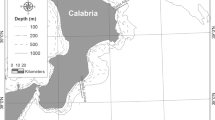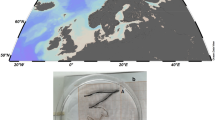Abstract
Heteropsyllus nunni Coull, a meiobenthic harpacticoid copepod is the marine crustacean to undergo a state of diapause within a cyst. A 12 month field study indicated H. nunni adults reached peak population densities in winter, with nauplii maturing in the spring, becoming adults by April or May.
At the last stage of development, a mature but unmated adult, they begin to prepare for encystment diapause. The copepods remain within their cyst in a state of diapause for 3–4 months during the summer only. Studies on the effects of temperature and photoperiod suggested that these two environmental cues are not crucial for induction or termination of diapause. Low temperature delayed development and time to encystment, while high temperatures accelerated development, making the time to encystment shorter. There were males than females in the cysts in laboratory experiments. Upon excystment, the copepods mate, and females begin egg production within one week. Adults that have excysted and mated die after a few weeks of active reproductive effort. Nauplii go on to mature and begin the univoltine diapause/reproductive cycle.
The copepods prepare for dormancy in two ways: they begin to produce and store two types of secretory products to be used in cyst construction; then they produce large quantities of lipid to be used as a nutrient supply throughout diapause. Histochemistry of the cyst-building material indicated the lower urosome is full of two chemically different products. Dorsally, there is a storage sac of proteinaceous material. The ventral sac of secretory product is a mucopolysaccharide. The copepod builds the spherical cysts in a matrix of small and large sand grains. The cysts fit tightly around the ventral portion of the animal in the its flexed position: however, there is a large space between the cyst and the sides of the copepod.
Biochemical analysis of the cyst showed it is composed of an amino acid complex similar to collagenous material. Scanning electron microscopy revealed a complex of large cuticular pores located in the lower urosome and caudal rami. There are specific pores for secretion of the two cyst-building products.
Similar content being viewed by others
References
Andrewartha, H. G., 1952. Diapause in relation to the ecology of insects. Biol. Rev. 27: 50–107.
Bamstedt, U. & A. Ervik, 1984. Local variation in size and activity among Calanus finmarchicus and Metridia longa (Copepoda: Calanoida) overwintering on the west coast of Norway. Plankton Res. 6: 843–857.
Bamstedt, U. & J. Hakanson, J. Frenner-Larsen, P. Bjornsen, O. Geertz-Hansen & P. Tiselius, 1990. Copepod nutritional condition and pelagic production during autumn in Kosterfjorden, western Sweden. Mar. Biol. 104: 197–208.
Cawood, A. H., U. Potter & H. G. Dickinson, 1978. An evaluation of Coomassie Brilliant Blue as a stain for quantitative microdensitometry of protein in section. Histochem. Cytochem. 26: 645–650.
Cohen, D., 1967. Optimizing reproduction in a randomly varying environment when a correlation may exist between the condition at the time a choice has to be made and the subsequent outcome. J. theor. Biol. 16: 1–14.
Cohen, D., 1970. A theoretical model for the optimal timing of diapause. Am. Nat. 104: 389–400.
Cole, G. A., 1953. Notes on copepod encystment. Ecology 34: 208–211.
Cooley, J. M., 1978. The effect of temperature on the development of diapausing and subitaneous eggs in several freshwater copepods. Crustaceana 35: 27–34.
Coull, B. C. & J. Grant, 1981. Encystment discovered in a marine copepod. Science 212: 342–344.
Danks, H. V., 1987. Insect Dormancy: An Ecological Perspective Biol. Sur. Can. Mono. 1: 439 pp.
DeStasio, B. T., 1990. The role of dormancy and emergence patterns in the dynamics of a freshwater zooplankton community. Limnol. Oceanogr. 35: 1079–1090.
Elgmork, K., 1955. A resting stage without encystment in the annual life cycle of the freshwater copepod Cyclops strenuus strenuus. Ecology 3: 739–743.
Elgmork, K., 1962. A bottom resting stage in the planktonic freshwater copepod Cyclops scutifer Sars. Oikos 13: 306–310.
Elgmork, K., 1973. Bottom resting stages of planktonic copepods in meromictic lakes. Ver. int. Ver. Limnol. 18: 1474–1478.
Elgmork, K., 1980. Evolutionary aspects of diapause in freshwater copepods. In W. C. Kerfoot (ed.), Evolution and Ecology of Zooplankton Communities. The University Press of New England, Hanover (N.H.): 411–417.
Elgmork, K. & A. Langeland, 1980. Cyclops scutifer Sars — one and two year cycles with diapause in the meromict ic lake Blankvatn. Arch. Hydrobiol. 88: 178–201.
Elgmork, K. & J. P. Nilssen, 1978. Equivalence of copepod and insect diapause. Verh. int. Ver. Limnol. 20: 2511–2517.
Fahrenbach, W., 1962. The biology of a harpacticoid copepod. La Cellule 62: 303–376.
Fryer, G. & W. J. P. Smyly, 1954. Some remarks on the resting stages of some freshwater cyclopoid and harpacticoid copepods. Ann. Mag. nat. Hist. 7: 65–72.
Gehrs, C. W. & B. D. Martin, 1974. Production of resting eggs by Diapatomus clavipes Schact (Copepoda: Calanoida). Am. Midl. Nat. 91: 487–489.
George, D. G., 1973. Diapause in Cyclops vicinus. Oikos. 24: 136–142.
Grimley, P. M., 1967. A tribasic stain for thin sections of plastic embedded OSO4 fixed tissue. Stain Tech. 39: 229–232.
Guillard, R. L., 1972. Culture of phytoplankton for feeding marine invertebrates. In W. L. Smith & M. H. Chaney (eds), Culture of Marine Animals. Plenum Press, New York: 20–60.
Hairston, N. G., Jr., 1987. Diapause as a predator-avoidance adaptation Impacts on Aquatic Communities. The University Press of New England, (N.H.): 282–290.
Hairston, N. G., Jr. & E. J. Olds, 1984. Population differences in the timing of diapause: Adaptation in a spatially heterogeneous environment. Oecologia 61: 42–48.
Hallberg, E. & H. J. Hirche, 1980. Differentiation of mid-gut epithelium in adults and overwintering copepodids of Calanus finmarchicus (Gunnerus) and C. helgolandicus (Claus. J. exp. mar. Biol. Ecol. 48: 283–295.
Harris, B., 1979. The mechanical behavior of composite materials. Symp. soc. exp. Biol. 34: 37–74.
Hayat, M. A., 1975. Positive Staining for Electron Microscopy. Van Nostrand/Reinhold, New York, 343 pp.
Hicks, G. R. F. & J. Grahame, 1979. Mucus production and its role in the feeding behavior of Diarthrodes nobilis (Copepoda: Harpacticida). J. mar. biol. Ass. U. K. 59: 321–33-.
Hirche, H., 1985. Overwintering of Calanus finmarchicus and Calanus helgolandicus. Mar. ecol. Prog. Ser. 11: 281–290.
Maier, G., 1989. The seasonal cycle of Thermocyclops crassus (Fisher 1853) (Copepoda: Cyclopoida) in a shallow eutrophic lake. Hydrobiologia 178: 43–58.
Maier, G., 1990. Spatial distribution of resting stages, rate of emergence from diapause and times to adulthood and to the appearance of the clutch in 3 species of cyclopoid copepods. Hydrobiologia 206: 11–18.
Marcus, N. H., 1980. Photoperiod control of diapause in the marine calanoid copepod Labidocera aestiva. Biol. Bull. 159: 311–318.
Marcus, N. H., 1982a. The reversability of subitaneous and diapause egg production by individual females of Labidocera aestiva (Copepoda: Calanoida). Biol. Bull. 162: 39–44.
Marcus, N. H., 1982b. Photoperiod and temperature regulation of diapause in Labidocera aestiva (Copepoda: Calanoida). Biol. Bull. 162: 45–52.
Marcus, N. H., 1987. Differences in the duration of egg diapause of Labidocera aestiva (Copepoda: Calanoida) from the Woods Hole, Massachesetts, region. Biol. Bull. 173: 169–177.
Miller, C. B., T. J. Cowles, P. H. Wiebe, N. J. Copely & H. Grigg, 1991. Phenolog y in Calanus finmarchicus; hypothesis about control mechanisms. Mar. biol. prog. Ser. 72: 79–91.
Naess, T. & J. P. Nilssen, 1991. Diapausing fertilized adults. Oecologia 86: 369–371.
Nagasawa, A., 1992. Newro peptides of the silkworm, Bombyx mori. Experientia 48: 425–440.
Nalepa, T. F., 1985. Occurence of a resting stage in cyclopoid and harpacticoid copepods in nearshore Lake Michigan. J. Great Lakes Res. 11: 59–66.
Nehring, S., 1993. Tube-dwelling meiofauna in marine sediments Int. Revue ges. Hydrobiol. 521–534.
Nilssen, J. P., 1980. When and How to Reproduce: A Dilema for Limnetic Cyclopoid Copepods. in W. C. Kerfoot (ed.), Evolution and Ecology of Zooplankton Communities. The University Press of New England, Hanover (N.H.): 418–424.
Sarvala, J., 1979. A parthenogenetic life cycle in a population of Canthocamptus staphlinus (Copepod: Harpacticoid). Hydrobiologia 62: 113–129.
Tande, K. S., 1982. Ecological investigations on the zooplankton community of Balsfjorden, Northern Norway: generation cycles, and variations in body weight and body content of carbon and nitrogen related to overwintering and reproduction in the copepod Calanus finmarchicus (Gunnerus). J. exp. mar. biol. Ecol. 62: 129–142.
Tauber, T. M. & C. A. Tauber, 1970. Photoperiod induction and termination of diapause in an insect: response to changing day lengths. Science 167: 170.
Tauber, M. J., C. A. Tauber & S. Mazaki, 1986. Seasonal Adaptations of Insects. Oxford University Press. pp. 411.
Taylor, F., 1980. Optimal switching to diapause in relation to the onset of winter. Theor. pop. Biol. 18: 125–133.
Taylor, B. E., G. Wyngaard & D. L. Mahoney, 1990. Hatching of Diapatomus stagnalis from a temporary pond after a prolonged dry period. Arch. Hydrobiol. 117: 271–278.
Waite, J. H. & K. Little, 1989. The glue protein of ribbed mussels (Geukensia demissa): a natural adhesive with some features of collagen. J. comp. Physiol. B. 159: 517–525.
Waite, J. H., 1990. The phylogeny and chemical diversity of quinonetanned glues and varnishes. Comp. Biochem. Physiol. 97: 19–29.
Watson, N. & B. N. Smallman, 1971a. The role of photoperiod and temperature in the induction and termination of an arrested development in two species of freshwater cyclopoid copepods. Can. J. Zool. 49: 855–862.
Wierzbicka, M., 1970. Contents of lipids in resting stages of copepoda, Cyclopoida. Polk. Arch. Hydrobiol. 17: 289–293.
Watson, N. & B. N. Smallman, 1971. The physiology of diapause in Diacyclops navus Herrick (Crustacea, Copepoda). Can. J. Zool. 49: 1449–1454.
Williams-Howze, J., 1992. Ecology and Functional Morphology of Heteropsyllus nunni Coull (Copepoda: Harpacticoida) with a review of diapause in the Cyclopoida, Calanoida and Harpacticoida. Ph.D. Thesis, University of South Carolina, pp. 189.
Williams-Howze, J. & B. C. Coull, 1992. Are temperature and photoperiod necessary cues for encystment in the marine benthic harpacticoid copepod Heteropsyllus nunni Coull? Biol. Bull. 182: 109–116.
Williams-Howze, J., J. H. Silverman & J. W. Fleeger, 1987. Internal morphology related to tube-building in the meiobenthic copepod Pseudostenhelia wellsi. J. crust. Biol. 7: 171–181.
Wyngaard, G., 1988. Geographical variation in dormancy in a copepod: evidence from population crosses. Hydrobiologia 167/168 (Dev. Hydrobiol. 47): 367–374.
Author information
Authors and Affiliations
Rights and permissions
About this article
Cite this article
Williams-Howze, J. The biology and morphology of the marine harpacticoid copepod Heteropsyllus nunni Coull, during encystment diapause. Hydrobiologia 320, 179–189 (1996). https://doi.org/10.1007/BF00016819
Issue Date:
DOI: https://doi.org/10.1007/BF00016819




